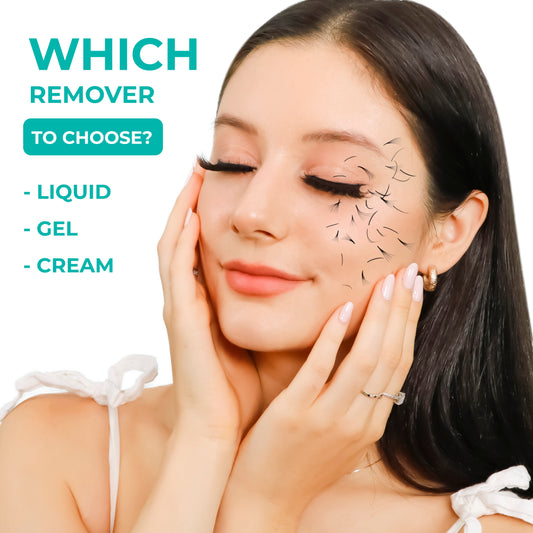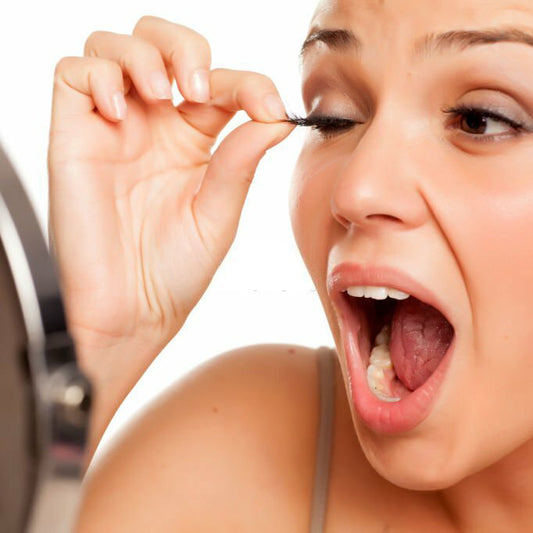Liquid, Gel, Cream Lash Remover: Which is the one for you?
When it comes to removing lash extensions, using the right type of lash remover is crucial. There are three main types of lash removers you will see in the market: liquid, gel, and cream. Basically, they all are removal solutions that help remove lash extension but each type has its own unique characteristics and benefits. This blog is your guide through the differences, ensuring you pick the right remover. Let's explore which one aligns best with your lash expertise!
1. Liquid Remover
Liquid lash remover is a popular choice among lash technicians due to its effectiveness and quick action. It is formulated with a thin viscosity that easily penetrates the adhesive bond, allowing for easy removal of lash extensions. Liquid removers typically work the fastest, but require more expertise to apply.
Advantages and Drawbacks
Liquid lash removers act quickly and efficiently, making them a preferred choice for many lash technicians. Their thin consistency allows them to penetrate the adhesive bond easily, making the removal process faster and more effective. This can save both the technician and the client valuable time.
While liquid lash removers have their advantages, they also come with a few drawbacks. One of the main concerns is their strong solvent composition, which can cause discomfort for individuals with sensitive eyes or skin. The liquid-like consistency of the remover also increases the risk of it getting into the client's eyes, which can be both uncomfortable and potentially harmful.
2. Gel Remover
Gel lash remover is another commonly used type. It has a thicker consistency compared to liquid removers, which allows for better control during application. Gel removers are often formulated with a combination of solvents and thickening agents, providing a longer contact time with the adhesive. This type of remover is ideal for stubborn or hard-to-remove lash extensions.

Benefits and Limitations
Gel removers offer controlled application and reduced risk of eye contact. Their thicker consistency ensures targeted application, making them optimal for removing specific lash extensions, such as a couple of strands. The gel texture prevents the formula from spreading to other areas, unlike liquids and allows for better control when working with the remover.
A gel eyelash remover is a good compromise between time and safety. While it may require longer dwell times for complete adhesive breakdown, it still only takes a couple of minutes. This makes it a suitable option for technicians who want to balance efficiency and safety. Additionally, gel removers are generally easier to apply for inexperienced technicians compared to liquid removers.
One limitation of gel lash removers is the longer dwell time required for complete adhesive breakdown. Compared to other types of removers, gel removers may need more time to effectively dissolve the lash adhesive. This can be a drawback for technicians who prioritize speed and efficiency in their work.
3. Cream Remover
Cream lash remover is a gentle option suitable for individuals with sensitive skin or eyes. Cream glue removers feature a creamy texture, which makes it adheres well to the lashes, allowing for a longer contact time with the adhesive, ensuring a gentle removal process.
Cream removers are typically formulated with moisturizing ingredients to minimize potential irritation. Their emollient base minimizes discomfort during adhesive dissolution.

Strengths and Potential Drawbacks
One of the major strengths of cream removers is their mild and soothing removal process. Additionally, cream removers offer ease of use.The thick consistency of the cream allows for better control and precision during application, preventing the formula from accidentally getting into your client's eyes, ensuring a comfortable experience. This makes cream removers suitable for lash technicians of all levels, from beginners to experts but is particularly beneficial for technicians who are still developing their skills or working with clients who may be more sensitive.
However, due to their gentler formulation, cream removers may take slightly longer to dissolve the adhesive and remove the lash extensions compared to liquid or gel removers.
Remover comparison
So now you have clearly known every types of lash glue remover, let's make a comparison of their own set of benefits and limitations:
- Liquid removers are fastest-acting and effective, but they may have a stronger odor and can be more drying to the natural lashes, easy to get into clients eyes.
- Gel removers provide better control during application and are ideal for stubborn lash extensions, suitable for specific, couple lash extensions removal, but they may require a longer processing time.
- Cream removers are gentle and suitable for sensitive individuals, with thick consistency help prevent eye contact, and irritation, but they may take longest time to remove lash extensions.
So, which remover to choose?
If you are an experienced lash artist, Liquid removers are an ideal choice for you thanks to their quick and efficient action, saving you time especially when dealing with a large number of lash extensions.
Gel removers, on the other hand, offer a more controlled application, hence, are suitable for lash artists at all levels and particularly suitable for clients with sensitive eyes or those who are prone to allergic reactions.
Cream removers are the gentlest option available. They are perfect for clients with extremely sensitive skin or those who have had previous allergic reactions to other remover types. They are the best options for beginner lash artists to avoid unwanted incidents.
How to remove lash extensions with removers?
No matter what types of removers you use, removing eyelash extension process is still the same. Here's a step-by-step guide to help you:
Preparation: Ensure your client's eyes are closed and properly covered with under-eye gel patches or medical foam tape to protect the lower lashes and skin.
Amount: Squeeze a small amount of the remover eyelash onto a clean, disposable microbrush or a lint-free applicator. Start with a small quantity, as you can always add more if needed.
Application: Gently apply the remover lash to the base of the lash extensions, where the adhesive is. Be careful to avoid contact with the skin or eyes. Ensure the cream does not spread to other lashes.
Wait Time: Leave the remover for few minutes for the formula to break down the adhesive bond.
Gentle Removal: After the wait time, use a clean microbrush or tweezers to gently start sliding or lifting the softened extensions away from the natural lashes. If the extensions do not easily come off, avoid forcing them to prevent damaging the natural lashes.
Cleanse: Once the extensions are removed, cleanse the lashes and the eye area thoroughly to ensure there is no residue. You can use our Shampoo at this step

Application Techniques and Considerations
Regardless of the type of lash remover used, it is important to follow proper application techniques and considerations. Here are some key points you should keep in mind:
- Always perform a patch test before using any remover for lash extensions to check for any allergic reactions or sensitivities.
- Use a microbrush or lint-free applicator to apply the remover directly to the lash extensions
- Avoiding contact with the skin or eyes. If contact occurs, rinse thoroughly with water for 15 minutes. If irritation persists, seek medical attention.
- Allow the remover to sit for the recommended processing time to ensure effective removal.
- Gently remove the lash extensions using tweezers or a lash comb, taking care not to pull or tug on the natural lashes.
YOU MAY ALSO LIKE
How to Remove Lash Extensions At Home Safe and Sound!
Lash Extension Aftercare: Everything You Need To Know
Cleansers and Primers: What’s the difference?







